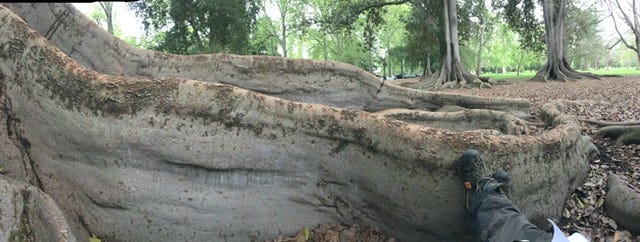A Profound Connection with Nature: Embracing the Fig Tree Experience
Written on
Chapter 1: The Enchantment of the Fig Tree
What compels me to occupy a park bench when I can enjoy the embrace of a tree? Not just any tree, but one that serves as a natural seat. This remarkable tree resembles a curved stone wall with cracks akin to imperfect plastering. It's the kind of place where children eagerly release their parents’ hands to climb and explore.
The fig tree (Ficus macrophylla) presents itself like a colossal octopus, its roots extending outwards in swirling patterns and rough textures. Its buttress roots create a seat so expansive that lying back against it obscures the view of its canopy. The experience is surreal, akin to being cradled in a nurturing lap. No park bench can rival the thrill it offers to the adventurous spirit.
As I settled in, absorbing the sounds around me, I found it hard to determine whether I was in the heart of the city or in a tranquil retreat. The moment I stepped out from the tree's shade, the cacophony of vehicles filled my ears, starkly contrasting the serene ambiance I had just experienced.
For a brief moment, I felt like nature itself was enveloping me, even within the urban landscape. The park is home to an impressive array of mature trees, including figs, London planes, Norfolk pines, and Eucalyptus. These giants are so vast that even the most passionate tree huggers would find themselves in awe.
However, as I sat there, the comfort began to wane, and my backside felt as though it were resting on a heavy slab. It was a sign that it was time to move. Just as I stood up, the delightful sound of crunching leaves caught my attention.
Do you remember the joy of stepping on leaves as a child? While it may be hard for many to recall, I felt a wave of nostalgia wash over me.
My focus shifted to the ground: The Ever-Changing Cycle of Life
The ground beneath revealed the various stages of decomposition through the green and brown leaves scattered about. The older leaves lay below, starting their transformation into organic matter. A quick glance at the ground reveals the rich, warm soil, especially noticeable during winter.
While standing under the flowering tree, I could hear the soft thud of fruits dropping to the ground.

Source: T. Miranda 2020
The wind dances among the leaves, creating a symphony as it moves through the branches, producing sounds reminiscent of a traditional African instrument. This gentle rustling contrasts beautifully with the lively chatter of birds — parrots, honeyeaters, red wattlebirds, lorikeets, rosellas, galahs, cockatoos, and many more frequent the area, showcasing the richness of South Australia's avian life.
As I returned my gaze to the ground, determined not to be distracted by the natural concert overhead, I felt compelled to dig my fingers into the earth. To my surprise, the soil teemed with life.
With a little effort, I soon uncovered earthworms, vital decomposers in our ecosystem. I was taken aback; it had been years since I'd last encountered these creatures. If examined under a microscope, countless microorganisms, including bacteria and fungi, would reveal themselves. This is nature’s intricate web, right at your fingertips.

Source: T. Miranda 2020
We often think that understanding nature requires formal education, but I believe anyone can unlock its mysteries. The only prerequisites are respect and curiosity. Questions will arise, and don’t shy away from them; they are your allies in exploring our diverse ecosystems.
Without inquiry, one may feel lost, isolated, and desperate for understanding, often leading to a misguided search for meaning. This journey does not have to detract from appreciating nature; rather, it can stifle your curiosity and skepticism — vital elements needed to grasp something greater than ourselves.
I’m not referring to a deity. Instead, I am speaking of the Universe and its remarkable processes.
If you still doubt your potential to become a citizen scientist, allow me to guide you further in the upcoming sections.

Source: T. Miranda 2020
Chapter 2: A Personal Experiment in Nature
The first video titled "God loves fig trees, apparently" offers insights into the significance of fig trees in various cultures, emphasizing their role in fostering connections with nature.
The second video, "Brand New to Growing Figs? Watch This..." serves as an excellent introduction for those interested in cultivating fig trees, providing essential tips and guidance.
To engage with nature, simply walk to your nearest park, find a bench beneath a tree (or a root flair), bring your lunch, and close your eyes. Listen to the sounds around you — the different calls of birds, the rustle of leaves, and the gentle breeze against your face.
Upon reopening your eyes, immerse yourself in this silent conversation of nature. There’s a language to be discovered, one that invites you to explore through physical cues and signs. As a mere observer, you will begin to understand that there's more at play than mere design or divine intervention.
This natural discovery is the "drug" that has captivated the likes of Charles Darwin, Bertrand Russell, Richard Dawkins, Thomas Jefferson, Christopher Hitchens, Stephen Fry, Neil DeGrasse Tyson, Carl Sagan, and countless others. You, too, might find yourself enchanted, just like me.
This "drug" is the endless pursuit of natural knowledge that continues to unfold without a return ticket. I encourage you to let it expand your horizons. Embrace humility, and you will realize, dear citizen scientist, that the world is brimming with wonders.